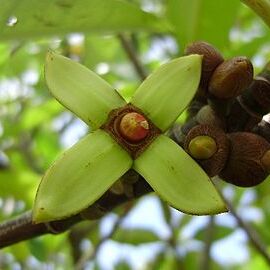Maritime trees and shrubs with adventitious aerial and prop roots, branchlets stout and furrowed, with prominent leaf and stipule scars. Leaves opposite, simple, entire, evergreen, coriaceous, often spotted dorsally; stipules foliose, sessile, cadu-cous. Inflorescence axillary, cymose, persistently bracteate. Flowers perfect, regular. Sepals 4, valvate, distinct, coriaceous, reflexed and persistent in fruit. Petals 4, alternate with the sepals, involute, often with hairy margins, caducous. Stamens 8-12, introrse, sessile, in one whorl, cuneate, areolate, a membrane covering the areolae opening at the inner edge to free the pollen. Ovary half-inferior, bilocular, the superior portion conical, surrounded by a fleshy disc; style terete, the stigma bifid or rarely trifid; ovules 2 per locule. Fruit a dry berry crowned by the persistent calyx, indehiscent. Seed 1 by abortion, suspended, germinating while the fruit is still on the tree.
Trees or shrubs of muddy shores and estuaries, with stout opposite branches. Aerial roots present as prop-roots and (adventitiously) developed from upper nodes. Leaves evergreen, opposite, petiolate, entire, leathery and glabrous. Inflorescences cymose; bracteoles paired and persistent. Calyx connate below, adnate to the ovary, 4 (–5)-partite, persistent, becoming reflexed. Stamens 8–12 in a single whorl; anthers narrowly oblong, longer than the filaments, basifixed, triquetrous, having numerous pollen sacs within a membranous epidermis. Ovary inferior to half inferior, 2-celled; placentae 2-ovulate. Fruit a leathery indehiscent berry. Seed usually solitary (very rarely 2), viviparous; endosperm absent. Hypocotyl terete, swollen subdistally, pointed. Embryo falling by separation from the cotyledons, leaving the fruit on the tree.
Trees of tidal habitats, supported by stilt roots usually branching and extending several metres from trunk; tap root aborted. Leaves usually elliptic to obovate; midrib extended into a caducous point; stipules lanceolate, reddish. Inflorescence a di-or tri-chasial cyme; bracteoles present, forming a cup just below flower. Sepals 4, scarcely united at base, leathery, reflexed in fruit. Petals 4, lanceolate. Stamens usually 8 or 12; filaments much shorter than anthers, or absent; anthers triangular in T.S., divided internally into many small locules, introrse. Ovary at least half-inferior, united with the leathery hypanthium, 2-locular; style sometimes very short. Fruit ovoid or pyriform, green or brownish. Fertile seeds 1 per fruit; germination viviparous; hypocotyl protruding up to 80 cm before propagule falls.
Trees or shrubs, with aerial roots. Stipules reddish, sessile, leaflike, lanceolate. Leaves opposite or distichous; leaf blade glabrous, midvein extended into a caducous point, margin entire or serrulate near apex. Inflorescences axillary, dense cymes. Bracteoles forming a cup just below flower. Calyx tube adnate to ovary, persistent; lobes 5-8. Petals 4, lanceolate. Stamens 8-12; filaments much shorter than anthers or absent; anthers introrse, locules many, dehiscing by an adaxial valve. Ovary inferior, 2-loculed, apically partly surrounded by a disk, free part elongating after anthesis; style 1, sometimes very short; stigmas 4. Fruit brown, ovoid, ovoid-conic, or pyriform. Fertile seed 1 per fruit; germination viviparous; hypocotyl protruding to 78 cm before propagule falls.
Shrubs or trees, with aerial prop roots and swollen stem nodes. Leaves: stipules sheathing terminal bud, caducous; blade surfaces glabrous. Inflorescences dense, dichotomously branched cymes; bracteoles forming cup just below flower. Flowers: sepals persistent in fruit; filaments absent [much shorter than anthers]; ovary apically partly surrounded by nectary, free part elongating after anthesis. Berries brown, ovoid-conic [ovoid or pyriform], leathery. Seeds: germination viviparous; hypocotyl protruding and elongating before seedling falls from fruit.
Fruit a leathery, indehiscent, mostly 1-seeded (very rarely 2–3-seeded) berry, included in and ± adnate to the calyx-tube, with a granular or roughened surface; cotyledons connate into a fleshy body continuous with but set off from a clavate, elongate hypocotyl which perforates the apex of the fruit and falls out of it; endosperm absent.
Stamens 4 epipetalous plus 4 or 8 episepalous, inserted on the margin of the crenulate disk, sessile or subsessile; anthers narrowly oblong, triquetrous, pointed, with numerous pollen-sacs within a membranous epidermis, multilocular, opening by a large ventral valve.
Leaves decussate, petiolate; leaf-lamina entire, leathery, usually black-dotted beneath, with nerves obscure below and visible or distinct above, midrib protruding at the tip into a caducous mucro; stipules large, lanceolate, ± red when fresh.
Wholly glabrous evergreen shrubs or trees of muddy sea-shores and estuaries, with stems supported by numerous aerial, adventitious, branched, capped prop-roots developed from the upper nodes; pneumatophores absent; branches stout, opposite.
Calyx glabrous, leathery, surrounded at the base by a persistent cup-shaped pair of bracteoles, accrescent and reflexed in fruit; calyx-tube ± adnate to the ovary; calyx-lobes 4(5).
Ovary inferior to semi-inferior, 2-locular, each locule 2-ovulate; style obscure or up to 6 mm. long, with a simple or shortly 2-lobed stigma.
Inflorescences cymose, simple or 2–3-dichotomously-branched, axillary, peduncled.
Petals entire, not clawed, inserted at the mouth of the calyx-tube.
Flowers bisexual, 2-bracteolate, shortly pedicellate.


